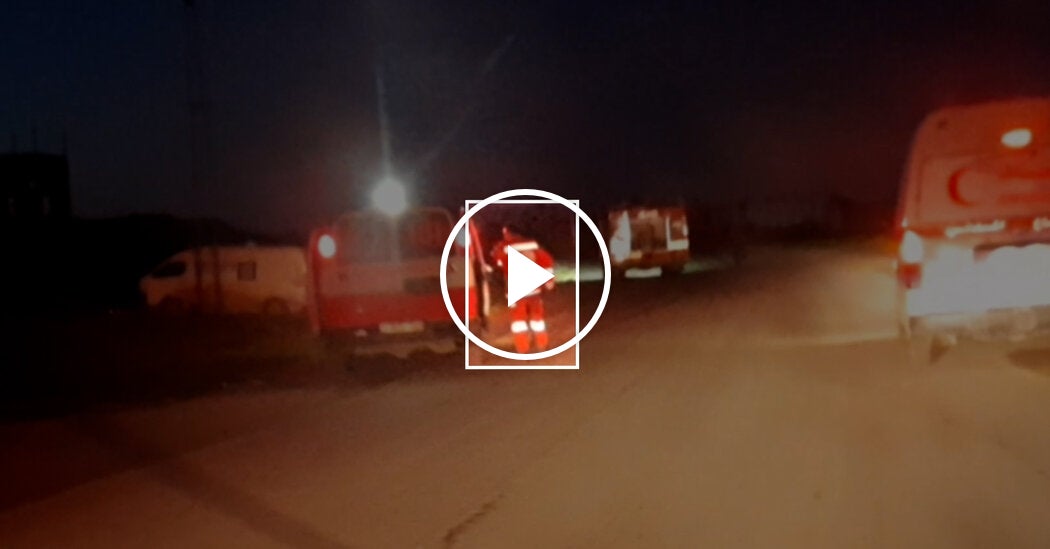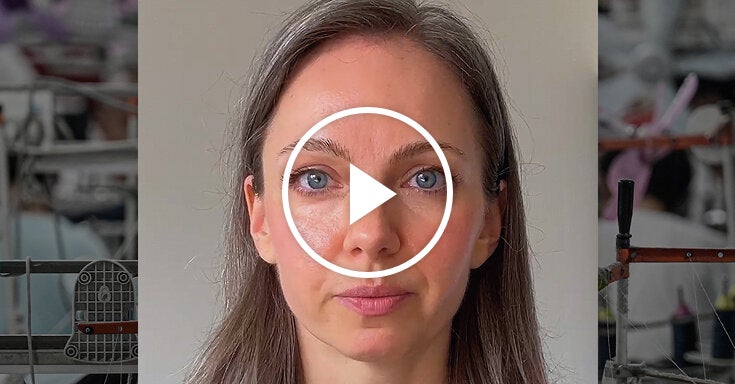It’s almost 5 a.m. on March 23 in Rafah, southern Gaza. Two Red Crescent medics are out searching for a missing ambulance crew. Driving is Asaad al-Nasasra and sitting beside him and filming is Rifaat Radwan. Both have worked with the Red Crescent for years. Rifaat worries their missing colleagues have come under attack. They haven’t heard from them for an hour. They will soon discover that Israeli soldiers have fired on the crew, killing two of them. Before long, Rifaat will also be killed along with 12 other staff from the Red Crescent, Civil Defense and the United Nations. The New York Times obtained Rifaat’s footage and reconstructed moment by moment how this unprovoked attack unfolded. We synchronized his video with another phone recording from the scene. We reviewed autopsy reports and photos of the bodies and we interviewed eyewitnesses. Our investigation shows how Israeli soldiers fired repeatedly on unarmed medics, closed in around them and continued shooting for more than six minutes, even as several of the crew were still alive, wearing their uniforms and praying. Investigating itself, the I.D.F. has said there were professional failures and dismissed the deputy commander who was involved. But independent experts say that to knowingly attack medics is a breach of the laws of war. Days before the attack, Israel had broken the cease-fire in Gaza with intense airstrikes after negotiations with Hamas to release hostages broke down. Ground forces had moved into Rafah, and on the night in question, the I.D.F. says it set up an ambush on this road ahead of an evacuation order to flush out suspected militants when people moved. Red Crescent crews were working overnight to rescue casualties from a nearby airstrike. But when one crew goes missing, others, including Asaad and Rifaat, are sent out to find them. In the darkness, they initially don’t see the missing ambulance. It had been passing by here just an hour earlier when the Israeli unit opened fire on it. They killed the two medics sitting in the front, Ezz al-Deen Shath and Mustafa Khafaja, and detained a third medic, Munther Abed, who survived. He told us what happened. Munther told us he was stripped and beaten. The I.D.F. said it thought the ambulance was a Hamas vehicle, and has long contended that Hamas uses ambulances to transport weapons and fighters. Back on the road, Rifaat and Asaad pass the Israeli soldiers without incident and meet up with other medics who were also out searching. Saleh Muammar, who was driving the other ambulance, says he spotted bodies on the ground. They ready the ambulances to return, but Saleh worries they will be attacked if they move ahead without more vehicles. A Civil Defense ambulance and fire engine joined them. And they continue on as a convoy. Overhead, an Israeli drone is watching them. The I.D.F. later said that a drone operator told soldiers on the ground the convoy was advancing suspiciously, but they are clearly marked as emergency services. And the vehicles are flashing their lights, which soldiers could see, the I.D.F. later told us. The medics pull in. Around 20 I.D.F. soldiers are positioned here, 100 feet off the roadside. Almost all of the first responders are clearly marked in reflective gear. They are unarmed and moving away from the I.D.F. Rifaat sees his colleagues bodies. As they rush to rescue them, they’re met by a hail of gunfire. [gunshots] Rifaat scrambles to the driver’s side and is shielded for now by the ambulance. He begins to pray. In total, Rifaat films almost six minutes of gunfire. We produced a condensed timeline that gives an insight into the I.D.F.’s actions. After the first barrage comes a 20-second pause. Rifaat repeats the Shahada — a declaration of faith that Muslims also say as they face death. An ambulance tries to escape. But another hail of gunfire erupts. We hear continuous single shots. Then automatic fire. Another pause. First responders can be heard screaming. Then another barrage from multiple rifles. None of these medics are armed, and all of the fire is coming from the I.D.F. A long pause, Rifaat asks his mother’s forgiveness. Steady gunfire, closer to Rifaat, now, for the full minute. An ambulance is shot at. Medics were still inside some of the vehicles. One of them, Ashraf Abu Labda — phones a Red Crescent dispatcher who records the call. We synchronized Ashraf’s call with Rifaat’s video to better understand what they both were seeing. Israeli soldiers appear to approach, shouting in Hebrew, but it’s unclear what they’re saying. Both Ashraf and Rifaat see them around the same time. From Ashraf’s phone call, slow, deliberate shots are heard now. An Israeli soldier orders his troops. Ashraf hangs up. Amid the emergency vehicles, Rifaat’s phone is positioned here. Three audio experts who analyzed his recording determined that the soldiers begin shooting up to 150 feet away. This aligns with where witnesses saw the I.D.F. positioned and where it built sand barricades. As the shooting continues, the gunfire closes in to within 60, 50 and then 40 feet of Rifaat by Minute 6 of the attack. Drone footage the I.D.F. showed The Times confirms that the soldiers moved in. Rifaat was still alive at this time. He was shot multiple times, his autopsy showed. And inside this ambulance, Ashraf was also alive. He was shot in the chest. A witness with a clear view of what happened, Saeed al-Bardawil, a civilian who was detained and held with the I.D.F. troops before the attack on the convoy. Saeed says that I.D.F. reinforcements later came, and then soldiers shot first responders as they lay on the ground. Minutes after the shooting, a clearly marked United Nations vehicle happened on the scene. The I.D.F. fired on it too, killing Kamal Shahtout, a U.N. employee who was on his way to rescue colleagues injured in another attack. Saeed says he saw the I.D.F. then bury both the bodies and vehicles. The I.D.F. said this was not done to conceal the attack, but in The Times’s experience of reporting on its actions in Gaza, burying bodies and vehicles is not something the I.D.F. normally does. Crushing the vehicles was an operational error, the I.D.F. told us. “Why did you hide the bodies? Why and why? They have to answer for that.” Younis Al-Khatib, the head of the Red Crescent, told us that for the next five days he begged the I.D.F. for information on the whereabouts of their missing staff. But the I.D.F. wouldn’t answer. Finally, the U.N., Red Crescent and Civil Defense got access to the site. It took two days to recover the medics’ bodies and vehicles. The Times reviewed autopsies and photographs of the bodies, which showed that most of the victims died from multiple gunshot wounds, including to the neck and torso. Three of the Civil Defense team were shot in the head. A Civil Defense helmet found there showed apparent bullet holes. Two bodies were missing, limbs, possibly shorn by the bulldozers burying them, and almost all of the Red Crescent and Civil Defense were wearing their uniforms in part or in whole. Since the attack, Israel has given shifting versions of events that the evidence contradicts. It initially said the medics were advancing suspiciously, but they never posed a threat. It said that the vehicles were without headlights or emergency signals, but changed that story two weeks later when The Times published Rifaat’s video. It said the area was a combat zone. It wasn’t until the I.D.F. declared it so hours after the attack. It named and said it killed a Hamas participant in Oct. 7. His family told us he’s alive in Gaza and he has no connection to the Red Crescent or Civil Defense. And it took weeks for the I.D.F. to admit it was detaining Asaad al-Nasasra, the medic driving alongside Rifaat, who survived. He was released after 37 days, having been denied access to a lawyer and his family. The I.D.F. has now released the results of its own investigation. It says there was a series of operational misunderstandings that started with misidentifying the first ambulance as a Hamas vehicle, and believing the convoy were Hamas reinforcements. It said Hamas has previously used ambulances. It said the deputy battalion commander, the most senior officer present, was the first to open fire on the convoy. He has been dismissed. But once the shooting started, the other soldiers followed procedure, the I.D.F. told us, even as they fired for six minutes unchallenged. Experts in the laws of war, including Janina Dill of Oxford University, told us that attacking medics who pose no threat is a likely war crime. Another expert, who has long studied attacks on health care, says this is not an isolated incident. “This incident was part of a much larger pattern where U.N. convoys, Doctors Without Borders, ambulances, humanitarian vehicles, have all been shot at multiple times with many people killed and injured.” The I.D.F. is satisfied that nothing needs to change in its orders to soldiers, which it described as excellent. The soldiers involved in this attack were from the Golani Brigade’s elite reconnaissance unit. A recent speech made by a commander of that brigade is an example of the types of orders those soldiers may receive. Even after 50,000 people have been killed in Gaza, this attack drew international condemnation. The agencies the slain medics worked for rejected the I.D.F.’s findings, and have called for an independent investigation.


